


























































 Roger Litwiller Canadian Naval Historian and Author
Roger Litwiller Canadian Naval Historian and Author
On November 11 each year, we gather to honour the service and sacrifice of Canadians during war and conflict. Historical battles like Vimy Ridge and the Invasion of Normandy are often dis cussed. These battlefields have forever scarred the land with destruction and were later commemorated with Cenotaphs and cemeteries to the soldiers and airmen that fought on and above the nowhallowed ground.

While on a cruise this October, I had the privilege to visit the location of two his toric Canadian Naval Battles in the closing weeks of the Second World War.
Unlike most naval battles, unseen on the distant oceans, these two took place within sight of Canada’s coast, with spectators on the shore.
The first, the Battle for Boston to Halifax Convoy BX-141, took place on Jan. 14, 1945. The 20 merchant ships in convoy were escorted by Canadian Escort Group EG-27, consisting of three new River-class frigates, HMCS Meon, Coaticook and Ettrick. The merchant ships were forming into line to pass through the anti-submarine nets and the safety of Halifax harbour when the German U-boat U-1232 fired at the convoy; torpedoes struck three merchant ships, SS British Freedom and SS Athelviking began to sink, and SS Martin van Buren was severely dam aged and later beached near Sambro.



The Royal Canadian Navy (RCN) frigates immediately started to hunt the unseen U-boat. Asdic conditions in the approaches are difficult at best due to the shallowness and the irregular bottom of the channel, the varying salin



ity of the water and other fac tors making it almost impos sible to gain a confirmed submerged contact. The frig ates dropped depth charges on several possible contacts without success. U-1232 remained undetected until HMCS Ettrick ran down the wake of a torpedo and col lided with the submerged U-boat, severely damaging the U-1232’s conning tower, peri scope, targeting system and radar. The hunt for U-1232 was joined by several RCN ships from Halifax and lasted several days. U-1232 had already escaped and was limp ing back to its base in Norway.
The attack took the lives of eight merchant sailors, but due to the closeness of the attack, HMC Ships Gaspe, Comox, Fundy and ML-102 were able to rescue 169 survivors.
The second battle was fought almost in the same location on April 16, 1945. The torpedoing of the mine sweeper HMCS Esquimalt by U-190 just three weeks before the war ended is a tragedy that will not be forgotten. Esquimalt had been sent out to conduct an anti-subma rine sweep of the approaches before a convoy departed
Halifax. U-190 was waiting for unsuspecting merchant ships when Esquimalt’s Asdic beam pulsed over the U-boat’s submerged hull. Again, due to the terrible asdic conditions, Esquimalt did not receive the return signal indicating they had found a U-boat. U-190, knowing they had been dis covered, turned away and fired an acoustic torpedo at the minesweeper. At 0630, the torpedo slammed into Esquimalt’s engine room; four minutes later, the mine sweeper was gone. Despite the speed of the sinking, many of Esquimalt’s sailors were able to abandon the ship. As the ship was operating alone and a distress signal could not be sent, it was many hours before the loss of Esquimalt was known. When the survivors were found, of the 71 RCN sailors in the minesweeper’s Ships Company, only 27 were still alive, many succumbing to exposure.
Other convoy battles were fought near Halifax during the war, including the loss of HMCS Clayoquot, torpedoed by U-806 on Christmas Eve 1944. The attacks on BX-141 and Esquimalt stand out. By this time, Germany was in full retreat in Europe. The
Canadian and Allied Armies had pushed the German Army back to their borders and were now poised to invade Germany. For many, the war in Europe was all but over.
Except for our Royal Canadian Navy, the German U-boats were still actively and aggressively pursuing their offensive operations, not just on the Atlantic Ocean but on the shores of Canada.


The first time I sailed from Halifax was in 1981 as an 18-year-old Sea Cadet in HMCS Ottawa (3rd), departing on a CARIBOPS. I was young, wide-eyed and eager to meet the adventure ahead. As compared to my recent voyage, now with age, experience, knowledge and wisdom, I stood at the rail of this massive cruise ship with a new appreciation of our RCN sailors and the merchant sail ors that passed through this same channel during the war, many never to return.



The battles our sailors fought, the sacrifices they made, and the ocean that became their graves are not marked with Cenotaphs or cemeteries. Standing at Chebucto Lighthouse today, observers could see the entire battle from the location. Sadly, there is no marker to tell the story of the tragedy.

Unlike the great battles on land that have scarred the earth with craters and shell holes for future genera tions, the ocean reclaims the battleground of our sailors as quickly as the battle began, washing over their ultimate sacrifice and memories.
Lest We Forget.
Many of us who have held the privilege of living in rela tive peace and stability find great challenge in appreciating the full magnitude of adversity faced by the generations who came before us.
For the thousands of members currently serving in the Royal Canadian Navy (RCN), walking into work at HMC Dockyard on a calm, sunny Halifax morning makes it dif ficult to imagine this same place, less than a century ago, as an assembly point for the countless ships serving in the Battle of the Atlantic, the success of which fundamentally supported Allied victory in the Second World War.
The hardship faced during the Battle of the Atlantic gives rise to some of the most inspiring stories of courage and heroism Canada has ever known. The story of Chief Petty Officer (CPO) Max Bernays is just one of these stor ies. It serves as an indispensable example of bravery which will continue to inspire generations of Canadians.
Born in 1910 in Vancouver, Max Bernays was from a sea-faring family. He spent his early years in the merchant marine before joining the Royal Canadian Naval Volunteer Reserve (RCNVR) in 1929, being mobilized for the Second World War a decade later.

With only limited experience in the position on smaller ships, Max Bernays was promoted to Acting Chief Petty Officer in March 1942 and appointed as Coxswain of the River-class destroyer HMCS Assiniboine, a position nor mally held by a more experienced sailor.
Bernays’ tenacity in the face of this seemingly insurmountable adversity guaranteed HMCS Assiniboine’s defeat of U-210, with minimal losses sustained to Assiniboine’s ship’s company.”
Young Max Bernays and his ship would soon be engaged in North Atlantic convoy escort operations under the leadership of Lieutenant-Commander John Stubbs.
On Aug. 6, 1942, just several months after CPO Bernays’ appointment as Coxswain, HMCS Assiniboine engaged in a fierce surface gun battle against the German submarine U-210. Both the bridge and wheelhouse of Assiniboine were engulfed by fire from shells launched by U-210 at close range.

Steering the ship as flames and smoke surrounded him, CPO Bernays ordered the two telegraph operators in the wheelhouse to leave for safety. Alone, injured, and trapped by the fire, CPO Bernays continued executing all helm orders while dispatching over 130 telegraph orders to the engine room.
CPO Bernays’ tenacity in the face of this seemingly insurmountable adversity guaranteed HMCS Assiniboine’s defeat of U-210, with minimal losses sustained to Assiniboine’s ship’s company.
For his bravery during Assiniboine’s confrontation with U-210, CPO Bernays was awarded the Conspicuous Gallantry Medal (CGM), a medal awarded to himself and only one other individual in the RCN during the Second World War.
The courage shown by CPO Bernays onboard HMCS Assiniboine was so impressive it caught the attention of
prominent RCN flag officer Rear-Admiral L.W. Murray. He recommended CPO Bernays be awarded the highly prestigious Victoria Cross (VC). Although, at the time, authorities in the United Kingdom decided the recom mendation did not meet the strict criteria required for the VC, strong feelings remained that CPO Bernays’ bravery deserved this higher award.

In September 2014, the Government of Canada announced each vessel in the RCN’s new class of Arctic and Offshore Patrol Ships (AOPS) would be named in honour of prominent Canadian heroes who had served the RCN. Subsequently, CPO Bernays became the namesake of Canada’s third AOPS.
The RCN accepted HMCS Max Bernays from Irving Shipbuilding Inc. on Sept. 2, 2022. The current inaugural crew of HMCS Max Bernays comprises a relatively small team of highly competent and highly-motivated sailors. All of them take great pride in the origin of their ship’s name.

The ship’s motto, ‘Interriti Impetus’, translates from Latin as ‘Undaunted by Fire’, a tribute to the heroism Max Bernays displayed while under enemy fire and surrounded by flames onboard the Assiniboine
The pride for HMCS Max Bernays felt by its crew has its roots in the heroic actions of CPO Bernays. His legacy has inspired many East Coast sailors during the ship’s short time in the Halifax Dockyard. It will undoubtedly inspire many more sailors for years to come with the transfer of HMCS Max Bernays to Esquimalt soon.
“The ship’s motto ‘Interriti Impetus’, translates from Latin as ‘Undaunted by Fire’, a tribute to the heroism Max Bernays displayed while under enemy fire and surrounded by flames onboard the Assiniboine.”Lt(N) Anastasiya Karakoy, HMCS Max Bernays UPAR





 Peter Mallett Staff Writer
Peter Mallett Staff Writer

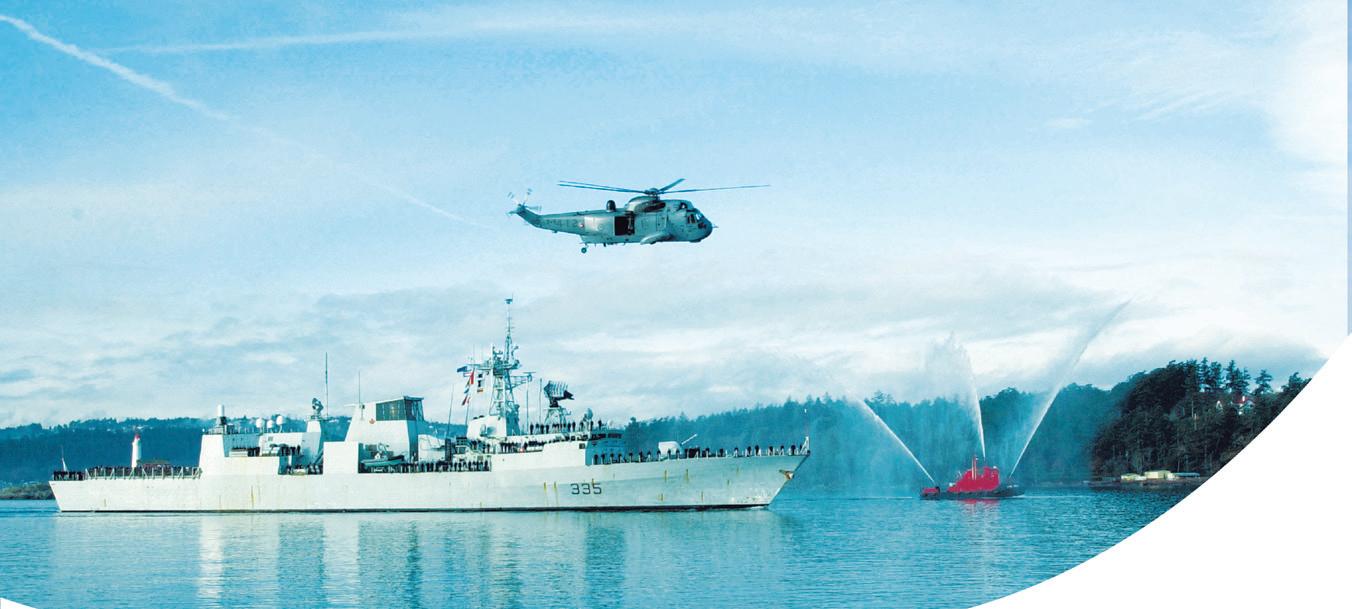


When Lieutenant (Lt) Grace Brodie joined the Women’s Royal Canadian Naval Service (WRCNS) in July 1942, she faced a unique challenge.
“No one had created a women’s uni form,” said Heather Feeney, Collections and Exhibits Manager at Maritime Museum of B.C. “Brodie was handed a stack of material and told to find a tailor of her own.”
But Lt Brodie, one of the first female ‘Wrens’, was tenacious and resource ful. Her Second-World-War-era dress uniform, created by a Vancouver-based tailor, is now part of a new exhibit at the Maritime Museum of B.C.


Feeney researched Lt Brodie’s uniform after it was donated by Lt Brodie’s estate executor, who also donated her Red Cross uniform to the museum’s collection and provided much of the background infor mation for Feeney’s research.
According to Feeney, the civil and mil itary tailor, John Doig of West Pender Street, was less than impressed with the idea of making a uniform for a woman. But Lt Brodie appealed to their shared Scottish heritage, and Doig embarked on the project.
Feeney notes Lt Brodie’s uniform is made from men’s uniform suiting, which gave the jacket a superior drape and sheen compared to those made from regulation serge.
The first alteration Doig made was to switch the standard Royal Canadian Navy (RCN) dress uniform buttons. The buttons would appear out of propor tion since Lt Brodie was only 5’1” (1.55 metres) in height. Doig suggested using mess buttons instead.
The rest of the story behind Lt Brodie’s uniform is part of the Douglas St. museum’s Darn It! Our Maritime Make and Mend Culture display.
Lt Brodie’s Royal Canadian Navy (RCN) career lasted from 1942 to 1945. All reports from that time indicate she was highly regarded and won the respect of her fellow officers.
According to biographical research files at the museum, Lt Brodie completed high school in Aurora, Ont., and did her basic training in Ottawa. She was then posted to the Naval Reserve training unit HMCS Discovery. The unit trained approximately 650 Wrens between 1942 and 1946. Lt Brodie was also present for the commissioning of RCN College in Esquimalt, B.C., on Trafalgar Day, Oct. 21, 1942.

An offbeat Royal Canadian Navy-related historical artifact – a Second World War ventriloquist’s dummy – is being high lighted at the Canadian Forces Base (CFB) Esquimalt Naval and Military Museum.

The dummy, Spike Ryan (or simply ‘Spike’), was the working ‘partner’ of ventriloquist Sheila Margaret Kidd. When she joined the Women’s Royal Canadian Naval Service (WRCNS) to contribute to the national war effort on July 4, 1943, she also brought Spike and her skills as a ventriloquist.
Just 20 years old when she signed up for wartime service, Wren Kidd was already a professional ventriloquist who had three years’ experience performing in clubs and theatres before becoming a ‘Wren’ (a term often used for women in the WRCNS). As a Wren, she was chosen to perform in the at-the-time very popular Meet the Navy shows with her notso-silent partner, a redheaded dummy named Spike Ryan.
Wren Kidd had developed her ventriloquist abilities during her teen years, when she suffered from painful throat ulcers.

“I discovered I could talk without moving my lips,” she explained in an August 1943 newspaper write-up.

“Wren Kidd took the skill she gained from her ailment and, using ingenuity and initia tive, parleyed this into a huge part of her career. These character traits prob ably served her well during her time as a Wren and we’re proud to be highlighting her,” said Tatiana Robinson, CFB Esquimalt Naval and Military Museum Curator.

Her performances with Meet the Navy attracted good reviews, although, at the time, a female ventriloquist was considered an oddity.
“For the first time in one’s life, one heard a girl ventriloquist, and a very skillful one, in the person of Sheila Kidd,” commented one reviewer. Meet the Navy was not an easy gig.
Mornings and afternoons were spent in rehearsals, and there were sometimes multiple performances in a single day as the show made its way to cities and towns across Canada, and eventually to the United Kingdom.

In a 1943 interview for the Toronto Daily Star newspaper, Wren Kidd observed that Spike’s a very ‘boastful type’, and went on to say he had acquired ‘a personality of his own’ since she joined the Navy.
“Now he is a sailor, through and through,” she said, “but he’s not as well-behaved as he might be.”

Little is known about Sheila Kidd’s life after she was dis charged from the service at His Majesty’s Canadian Ship Discovery, Vancouver’s Naval Reserve Division, on Nov. 23, 1945. Sheila Kidd was still working as a ventriloquist with Spike as her partner as late as 1959. Historians believe that she may have married since there is documentation showing her last name as Lockert and her last known place of residence was Regina. That said, many details are unknown and there is a lot of mystery surrounding Wren Kidd, what became of her, and the details of her later ventriloquism career.

The story of the museum reviving Wren Kidd’s story started when Spike was donated to the CFB Esquimalt museum in 2011 by Clarice Force, who, remark ably, found the dummy in a thrift store. Ms. Force also donated a file of newspaper cuttings and documents about Spike Ryan and Sheila Kidd that helped historians research her story.

“Sheila Kidd was a unique Wren and an unusual talent for her time,” Robinson said.
“There were few female ven triloquists in the 1940s so her story is a singular one. Spike being offered to this museum and rescued from a thrift store presented us with a great oppor tunity to tell a fascinating story.”

To find more information about the museum, where Spike is stored, visit navalandmilitarymuseum.org..
John McCrae and the Battles of Flanders John McCrae—doctor, gunner and poet—was shaken by the battlefield death of a friend in May 1915, and wrote the poem “In Flanders Fields” in tribute. The poem remains today a renowned symbol of remembrance.

Manager
Jazmin Holdway 250-363-3372 Jazmin.Holdway@forces.gc.ca
editor



Kate Bandura 250-363-3130 kateryna.bandura@forces.gc.ca
Writer Peter Mallett
pkmallett@shaw.ca



ProdUC tion teresa Laird 250-363-8033 production@lookoutnewspaper.com Leslie eaton 250-363-8033 workstation3@lookoutnewspaper.com


aCCoU nt S / reC eP tion trina Winters 250-363-3127

advertiSing rePreSentative Joshua Buck 778-977-5433 sales@forcesadvertising.com editoriaL adviSor Capt Jeff Klassen 250-363-4006

Published each Monday, under the authority of Capt(N) J. Jeffrey Hutchinson, Base Commander.

Le LOOKOUT est publié tous les lundis, sous l’égide du Capv J. Jeffrey Hutchinson, Commandant de la Base.
The editor reserves the right to edit, abridge or reject copy or advertising to adhere to policy as outlined in PSP Policy Manual. Views and opinions expressed are not necessarily those of the Department of National Defence.

Le Rédacteur se réserve le droit de modifier, de condenser ou de rejeter les articles, photographies, ou annonces publicitaires pour adhérer au Manuel des politiques des PSP. Les opinions et annonces exprimées dans le journal ne réflètent pas nécéssairement le point de vue du MDN.

CFB Esquimalt, PO Box 17000 Stn. Forces, Victoria, BC V9A 7N2 Web: www.lookoutnewspaper.com Fax: 250-363-3015 Canadian Mail Product Sales Agreement 40063331



Every commissioned warship in the Royal Canadian Navy (RCN) is hon oured with an official ship’s badge based on the ship’s name and designed with heraldic elements. The badge serves as a unifying symbol for the ship’s company.
Before the Second World War, there was no official control over the badge a Canadian warship might wear. During the Second World War, with Commanding Officers and crew members coming up with their designs, we saw ships embla zoned with Donald Duck, as in HMCS Snowberry, or an image of St. Clair blast ing a U-boat with lightning flashing from her fingertips, as in HMCS St. Clair. HMCS St. Laurent, a ship named ‘Sally Rand’, had a picture of the famous bur lesque dancer knocking down dive bombers with her fan. HMCS Wetaskiwin displayed an image of the Queen of Hearts sitting in a puddle of water. These badges boosted morale and offered a uniting symbol for the ship’s crew. However, at the end of hostilities, something more official was warranted.
In 1945, Naval Staff decided that ships remaining in ser vice should have official badges designed with the elements of heraldry. The task of producing official badges for the RCN was initially given to Lieutenant-Commander Alan Brookman Beddoe (1893-1975), a Canadian war artist, consultant in heraldry, and former First World War prisoner of war. Incidentally, Beddoe also illustrated the Books of Remembrance on display in the Peace Tower on Parliament Hill in Ottawa.
Badge designs are made to connect to the ship’s name, and incorporate heraldic symbology and terminology. For example, colours are described using the heraldic terms gules (red), azure (blue), vert (green), sable (black), purpure (purple), or (gold), and argent (silver or white). In heraldic
language, the badge of HMCS Calgary is described as, ‘Or, a bend wavy azure charged with a like bendlet argent. In front across the centre of a bow stringed fess-wise, and arrow point upwards in pale, both sable’. The term fess refers to the horizontal direction, and pale refers to a vertical direction.

HMCS Calgary’s badge, consisting of a bow and arrow over a wavy background, refers to the region’s Indigenous people and the Bow River, an important local geographical feature. While most badges seek this kind of connection to the ship’s name, some badges contain a rebus, such as a badge for HMCS Discovery that features a yellow disc over a white letter ‘y’. Thus, “disc-over-y” = HMCS Discovery

Battle Honours are assigned to a warship, and with con tinuous service, they can carry forward to other ships with the same name. A specially made Battle Honours Board is a fixture in all HMC ships and is proudly displayed on the quarterdeck when the brow is operational.
Many Naval Reserve Divisions, such as York in Toronto, Hunter in Windsor, and Queen in Regina, bear names of ships whose histories go back to the 16th Century. The commissioned ship with the most extended battle hon ours is HMCS Unicorn, a stone frigate in Saskatoon, Sask. Named after one of the first vessels to enter Hudson Bay in search of the Northwest Passage, this name serves as a point of pride to these prairie sailors as Unicorn carries a list of fifteen battle honours from Armada (1588) to Korea (1950-53).
You will find over 4,000 examples of Jackspeak in my book Jackspeak of the Royal Canadian Navy (2nd ed.).
The author of ‘Jackspeak of the Royal Canadian Navy’ and ‘Whiskey 601’, Mark Nelson developed a love of the Navy's language and lifestyle over his 26-year career in the service. After retiring as a Chief Petty Officer Second Class, he now works as a Library Systems Specialist at Red River College Polytechnic in Winnipeg, Man.
Follow Mark on Twitter @4marknelson
“While most badges seek this kind of connection to the ship’s name, some badges contain a rebus, such as a badge for HMCS Discovery.”
~ Mark Nelson, Chief Petty Officer Second Class (Retired)























A pair of portholes are grim reminders of destruction during the Battle of the Atlantic.

The mangled portholes, bronze bent from the force of the explosion, “are the real story of the sinking of the Trentonian,” said Roger Litwiller, a Canadian naval historian and author, in an interview with Legion Magazine. He donated the two artifacts from the ship to a pair of Canadian museums in late 2021.

The Royal Canadian Navy modified Flower-class ship was the last corvette sunk during the Second World War’s Battle of the Atlantic. On Feb. 22, 1945, it was escorting a convoy in the English Channel when it was torpedoed and sunk by German sub marine U-1004 just 20 kilometres from Falmouth on England’s southern coast.


“The torpedo struck us aft with a terrific explosion and the corvette went down in 10 minutes,” said Lieutenant Ralph Abbott, Navigating Officer, in a newspaper account at the time. After destroying the charts, he abandoned the ship. “Some of the men sang while awaiting rescue,” but Abbott had to swim for about 45 minutes before rescuers arrived.
The survivors, including several wounded, were picked up by motor launches. Six of the 101 crew members died.




The wreck lay scattered over the sea floor some 50-plus-metres deep, undis turbed for decades, providing habitat for fish and marine plants. But recently, it has attracted recreational divers.
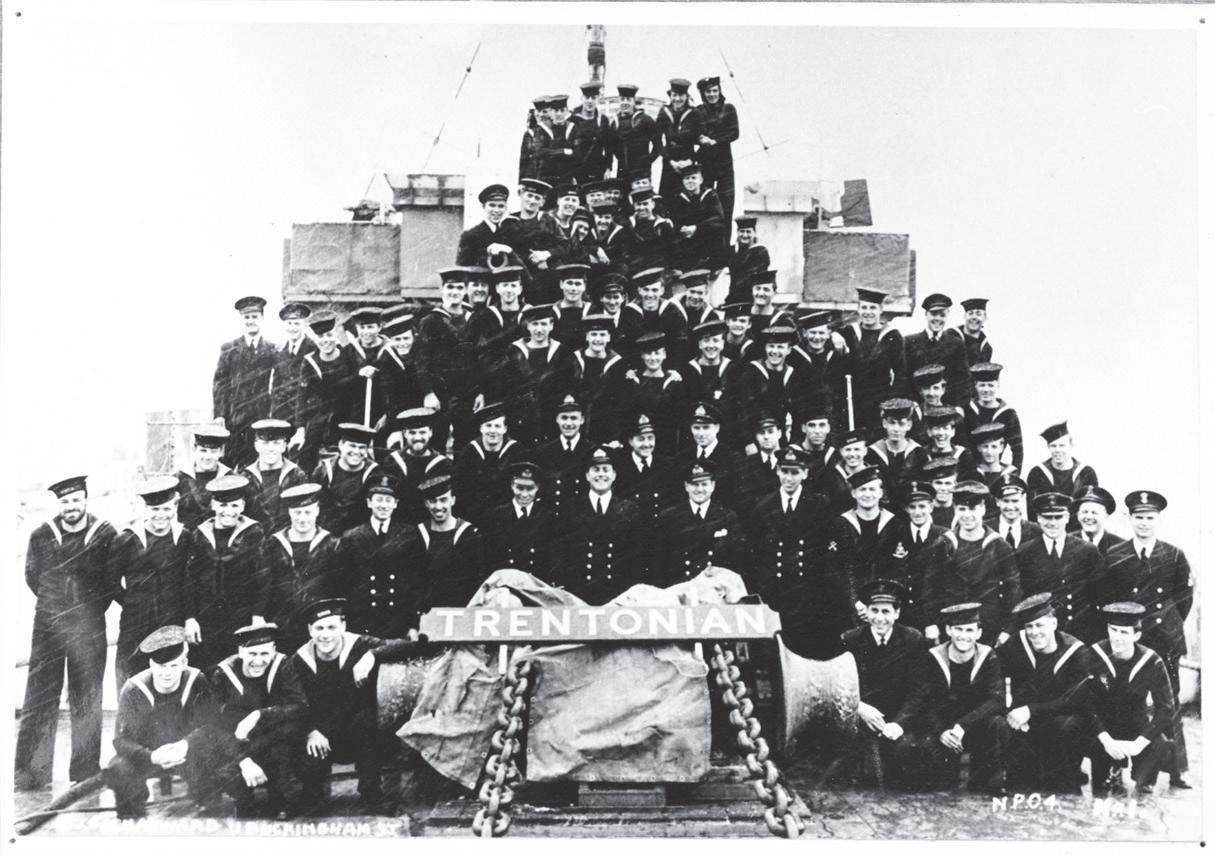


In May 2021, Litwiller, author of White Ensign Flying: Corvette HMCS Trentonian, was contacted by the president of a British diving club. Although the club’s members had been warned of the British law protecting undersea wreckage of Second World War ships and aircraft, many of which are considered gravesites, two of the club’s divers had retrieved port holes from Trentonian
The club could not safely return the artifacts to the wreck site, so the president searched for a home for the historical items and offered them to Litwiller. He accepted them.
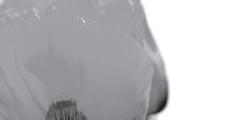
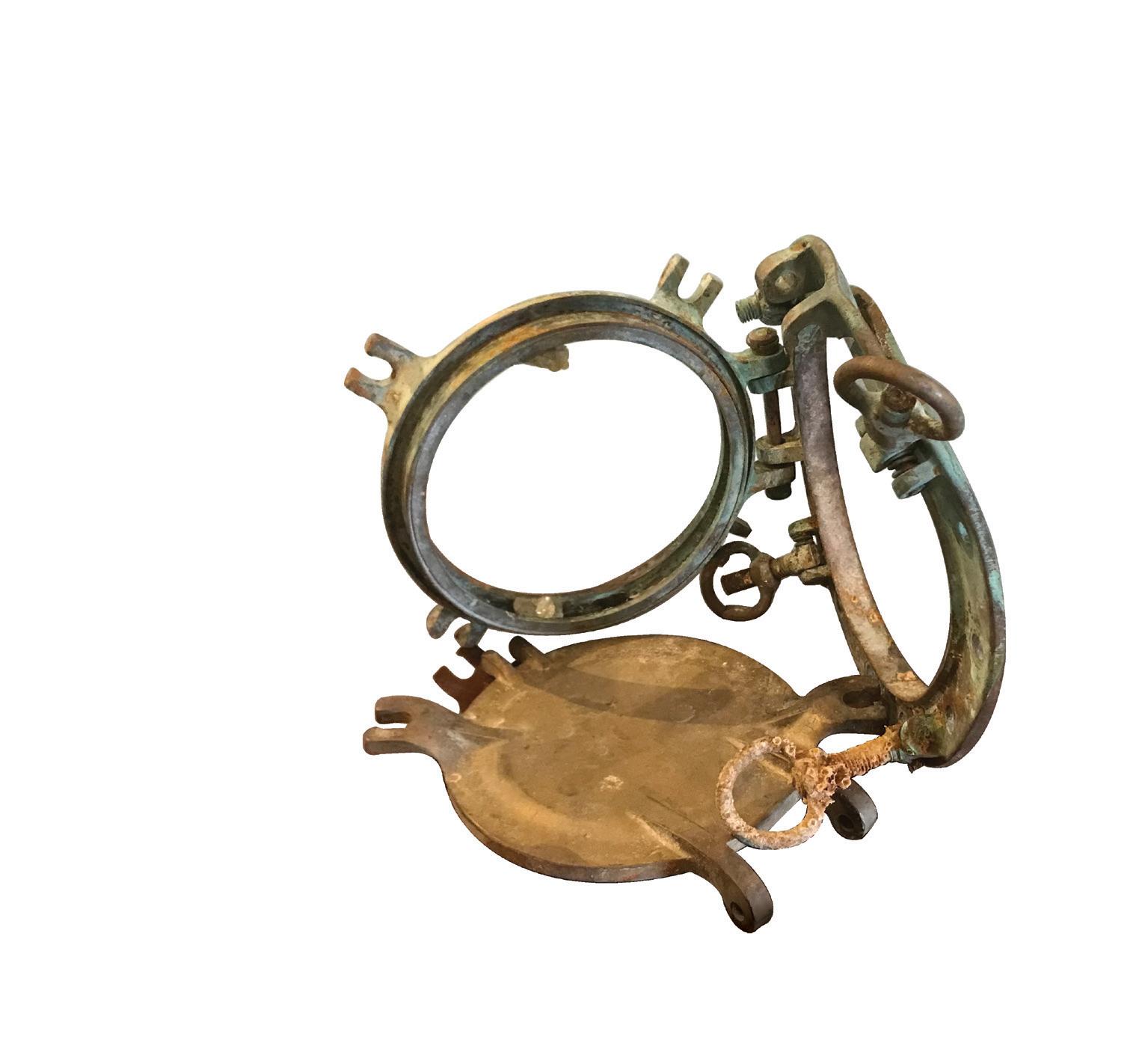
After receiving the portholes in the mail, Litwiller donated them to two museums— one to the Naval Museum of Halifax, as Trentonian had sailed from the city’s port early in its service, and the second to the Marine Museum of the Great Lakes in Kingston, Ont. It was here at this former shipyard on Lake Ontario (now a national historic site) that shipwrights crafted the corvette.
Said Litwiller: “Artifacts like these are of such huge historic significance.”

The latest feature photo from the museum archives tells a tale of two heroes, two leaders, two men who shaped history. Each played a key part in the Battle of the Atlantic, the epic seaborne struggle to defeat Nazism. Each was an inspiration to those who served with them, and to those they served.
The Right Honourable Winston Spencer Churchill and Lieutenant John Hamilton Stubbs of the Royal Canadian Navy met in the run-up to a decisive summit conference. Stubbs and the ship he commanded, HMCS Assiniboine, were detailed to escort Churchill, then-prime minister of Great Britain, to a secret meeting.
Assiniboine sailed with the Royal Navy vessel HMS Prince of Wales, which carried Churchill aboard, to Placentia Bay, Nfld. Stubbs and his men reportedly received little notice they would accompany Churchill to his now-famous first encounter with Franklin Delano Roosevelt, U.S. president. Their ren dezvous took place at sea in early August 1941, just offshore from the little community of Ship Harbour, Nfld.
The British and American leaders joined together for secret talks – the U.S. was not yet in the Second World War, and negotiations were delicate. Their historic meeting resulted in a strategic set of agreements that gave birth to the Atlantic Charter and laid the ground work for destruction of the Axis powers.
Shortly before their escort detail, Stubbs and Assiniboine had successfully sunk the subma rine U-210, ramming the submarine twice and finishing it off with depth charges. Naval his torian G. N. Tucker, who witnessed the action from the destroyer’s bridge, considered it a masterpiece of tactical skill on Stubbs’s part. Tucker observed that although Assiniboine’s bridge was deluged with machine gun bullets, Stubbs never took his eye off the U-boat, and gave his orders as though he were talking to a friend at a garden party.
Like Churchill, Stubbs was known for his strength under pressure and inspirational leadership. He left Assiniboine in October 1942 – now promoted to LieutenantCommander – to command his next ship, HMCS Athabaskan, a Tribal-class vessel with an unhappy reputation. Stubbs, who is described by historian Dr. Michael Whitby as a quiet, laid-back man with a strong sense of humour, quickly restored morale aboard Athabaskan, and ran an efficient yet relaxed ship.
Athabaskan was assigned to Plymouth Command to conduct offensive sweeps off the French coast. Stubbs’ skills proved well-suited to the fast-paced night surface actions, and he was awarded the Distinguished Service Cross for his role in a battle in which Athabaskan and her sister-ship HMCS Haida played crucial roles in sinking the German destroyer T-29 on April 26, 1944.
Dr. Whitby recounts that three nights later, Athabaskan and Haida were on patrol in mid-

Channel under Commander Harry DeWolf when they were ordered to intercept two German destroyers (survivors of the earlier battle) heading westward along the French coast.
“Athabaskan’s radar soon detected the enemy ships; minutes later, the Tribals opened fire, then altered course towards the enemy to ‘comb’ possible torpedoes (that is, turn parallel to incoming torpedoes). In spite of this man euver, a torpedo found Athabaskan. The hit caused such devastation that Stubbs ordered the crew to stand by in readiness to abandon ship,” Dr. Whitby says.
In the early morning hours, as decks crowded with men, Athabaskan’s 4-inch magazine erupted in a massive blast. Most of those on the port side were killed, and many others were burned by searing oil that rained down on the upper deck. Survivors took to the cold waters of the English Channel as their ship began to sink beneath them, Dr Whitby recalls.
Stubbs is said to have sung to his men stanzas from a tune about naval volunteers called ‘The Wavy Navy’ while they waited in the freezing water. Badly burned and last seen clinging to a life-raft, John Stubbs was among the 128 who perished in the attack on Athabaskan. He was awarded the Distinguished Service Cross (DSC) after his death.
The quiet heroism and dedication to duty demonstrated by John Stubbs have become a rightful part of the rich traditions of the Royal Canadian Navy.

At the onset of the Second World War, many brave Canadian women challenged the traditions of the time and volunteered to serve their country. Jenny Pike was one of those trailblazers.
Serving as one of the first women photographers during the Second World War at only 22 years old, Jenny was responsible for processing some of the first photographs from the D-Day landings. Her passion and dedication to service helped open doors for future generations of Canadian women.
The youngest of four children, Jenny Whitehead Pike, was born in Winnipeg in 1922. As early as age 11, Jenny was sure she would become a photographer and often helped in her brother’s photo lab. Later, this experience would serve her well when she was hired to work in the photography department of Eaton’s department store.

In early 1943, with the Second World War underway, Jenny’s father helped her write a letter to the Secretary of the Naval Board offering her photography services. His support was unusual in an era when many parents disapproved of their daughters joining the Forces. There were no vacancies then, but Jenny was encouraged to join the Naval Service as a Probationary Wren.
The Women’s Royal Canadian Naval Service (WRCNS) seemed like a good life, and Jenny registered in February 1943. She trained at HMCS Conestoga in Galt, Ont., before being posted to Ottawa HQ for photo training. Jenny was one of only seven young women in the first class. From there, she went on to Halifax in October 1943, and in February 1944, she sailed in the third draft to London, England. She had been in London just four months when the D-Day invasions began.

Jenny’s proudest memory of the war was her recollecting the
first photographs from the D-Day landings. They were the first pictures of the Allied onslaught to be released and were picked up by the newspaper wire services. Jenny was the only woman working in the darkroom at the time.
She returned home from England in April 1945, narrowly missing the Victory in Europe (VE Day) celebrations, to her lasting regret.
In 1949, Jenny married Chief Petty Officer Second Class Donovan Pike, a boy she had grown up with and met again when they were both discharged from the Navy. Donovan loved Navy life and, with Jenny’s encouragement, re-enlisted. The couple moved to Victoria, a city they both loved. They had two children, a son, Jim and a daughter, Susan. Donovan Pike died in 1977.
In 1969, Jenny became a darkroom technician for the Victoria City Police, finally retiring in 1983. Despite problems with her sight, Jenny continued to be an avid photographer and camera club enthusiast, always looking for the perfect shot. In the early 1980s, Pike worked as a film crew member on The Glitter Dome, providing photography and appearing as an extra in the film.
She also maintained her interest in service organizations, initially joining the Royal Canadian Legion in Winnipeg in 1946 and later transferring to Ex-Service Women’s Branch 182 in Victoria. She was President from 1982-83. She was also active in the ex-WRCNS Association of Victoria. Jenny passed away in 2004.
“Jenny was so proud to have served her country,” recalled Barbara Fosdick, former President of Ex-Service Women’s Branch 182.

“My favourite memory of her is from the recent Remembrance Day parade, when all the women were told they must march at the back of the parade. Jenny in her wrath was mighty to see,” Fosdick said. “With fists clenched, she yelled, ‘We are women veterans, we will NOT march at the back, we’re going to join the men where we belong.’ And we did.
To learn more about Jenny’s story, visit the CFB Esquimalt Naval and Military Museum, open 7 days a week from 10 a.m.–3:30 p.m. To learn more visit, wwwnavalandmilitarymuseum.org


Traversing the ocean uncontested was one of the great struggles in what modern history considers the beginning of humanity’s greatest war. As Britain and Canada were engaged in an arms race with Germany, these counties’ navies invested in developing an air arm, which would provide a significant advantage against the struggle.
Starting in the First World War, the submarine was the greatest threat to the unrestricted movement of goods across the ocean. Upon realizing these subsurface vessels seriously endangered this invaluable freedom, Britain invested in the best anti-submarine assets available – naval aviation.

This investment led to the Royal Naval Air Service (RNAS) formation in 1915, an air branch for the Royal Navy. The RNAS’ dut ies would be carrier-based, filling the gap between the Navy and the Airforce. Upon the first formation in April 1915, the first British naval aviators were over 600 Royal Canadian Naval Service members. The RNAS was disbanded three years later, merging with the Army’s Royal Flying Corps, thus forming the Royal Air Force.
Canada first attempted to form a naval air service on Sept. 5, 1918, establish ing the Royal Canadian Naval Air Service. Like the RNAS, it was short-lived; the Armistice signing in November 1918 ended Canada’s first descent into naval aviation.
Near the end of the Second World War, the Royal Canadian Naval Air Service was revived with aircraft carriers, HMCS Nabob and

HMCS Puncher. Although Canada had these in service, they were commissioned as the UK’s Royal Navy Ships.
According to Bertram C. Frandsen, writer of The Rise and Fall of Canada’s Cold War Air Force, 1948-1968, Canadian sailors manned both ships, and the aircrews were members of the Royal Navy Fleet Air Arm RCN Reservists served as pilots, but only under service for the Royal Navy Fleet Air Arm. Canada would have to wait until the end of the Second World War before a distinct Royal Canadian Navy (RCN) Fleet Air Arm would come into being.
On Jan. 24, 1946, the RCN commissioned its first official aircraft carrier, His Majesty’s Canadian Ship Warrior, formerly known as HMS Warrior. Formed the same day, 825 Squadron and 803 Squadrons became the first official RCN air squad rons. The name was offi


cially changed to the Royal Canadian Naval Air Branch (RCNAB) the following year, marking the beginning of a brief but bright age for Canada’s naval aviation.
The Warrior acquired the first anti-submarine warfare (ASW) helicopter squad ron, along with HMCS Magnificent. This mari time helicopter idea was so successful that in the early 1960s, the St. Laurent-class destroyers were upgraded to destroyer-helicopter ves sels, complete with heli copter flight decks. The upgrades made the RCN the first navy in the world to use helicopters on small surface ships. The success of this new branch led to the RCN Reserve acquiring more aviation-related assets and gaining the authority to form their air squadrons.
In November 1955, the RCN obtained its first fighter jet, the F2H3 Banshee all-weather fighter, known as Canada’s crown jewel of
naval aviation. This singleseat jet-propelled fighter was a great source of pride for Canadian naval aviators, even outperforming the RCAF’s CF-100 jet fighter.

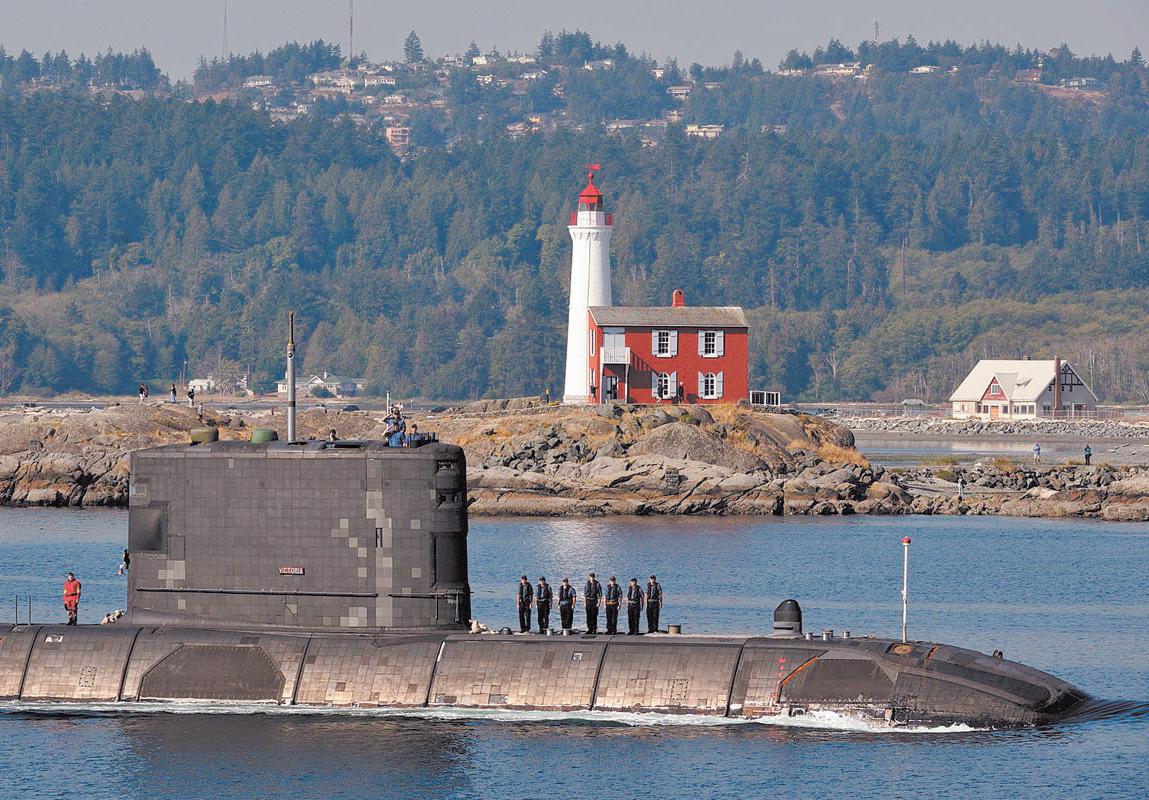
In 1962, the RCN had begun disbanding many of its post-war carriers and turned down offers to purchase new ones. The unification of the Canadian Armed Forces in the mid-1960s sparked the end of the RCNAB. The Naval Air Branch became Maritime Air Group, a subunit of Maritime Command. HMCS Bonaventure , Canada’s only remaining air craft carrier, was decommis sioned in 1970.
While helicopters would still be attached to Canada’s frigates and destroyers, all of the fleet’s fixed-wing air craft became shore-based.
The Royal Canadian Naval Air Branch ceased to exist in 1975 when Air Command

assumed control of Maritime Air Group, ending Canadian naval aviation.

Canada’s Naval Aviation made such an impact in hist ory that the Japanese govern ment erected a memorial on the shore of Onagawa Wan, Japan, in 2006 for Lieutenant Robert Hampton Gray, a Second World War RCN pilot. He perished after lead ing and destroying a Japanese destroyer on Aug. 9, 1945. This memorial is an honour so rare that it marks him as the only member of a foreign military to be so honoured.
Naval aviation is still a critical component that makes Canada’s current standard of international deployments possible. The Royal Canadian Naval Air Branch’s legacy remains despite its brief existence. The experiences gained from the many hurdles may become an invaluable lesson for all who wish to develop or improve on a naval air branch.
Ahead of Remembrance Day ceremonies, Grade 6, 7 and 8 students from Rockheights and Cedar Hill Middle School visited the gravesites of veterans to remember the sacrifices and pay their respects while leaving poppy-painted stones on their headstones.
They were among thousands of students across the coun try taking part in the annual Remembrance Day scholastic program, No Stone Left Alone (NSLA).
“It makes Remembrance Day more meaningful,” says Christina Pelletier, Vice-Principal at Rockheights Middle School. “The act of painting poppies onto rocks and then placing them on headstones honours the soldiers and creates a greater appreciation for all of those who served.”

The annual campaign was launched in 2011 by Edmonton’s Maureen G. Bianchni to recognize the nation’s fallen.
Soggy cold weather greeted Cedar Hill Middle School students on Nov. 3 at St. Luke’s Cemetery in Saanich and

Rockheights Middle School students on Nov. 4 at God’s Acre Veterans Cemetery in Esquimalt.
The NSLA’s goal is to educate and engage youth in hon ouring every soldier who has fought for Canadian freedoms, says Maryanne Trofimuk, Principal at Cedar Hill Middle School.
“Hands were red, glasses were fogging, knees were knock ing, but the spirit was strong,” Trofimuk said.
Trofimuk was previously the Principal at Rock Heights when her school became the first in the province to organize a No Stone Left Alone ceremony at the request of retired major-gen Cam Ross.
This was Rockheights Middle School’s ninth No Stone Left Alone Ceremony.
Despite braving rain, wind and cold temper atures, standing out in the cold for a short time was nothing compared to what
soldiers at war go through, said Gio, a Grade 8 student from Rockheights Middle School.
“I think it’s very important we do this ceremony and remember those who served in the Canadian Forces and what they went through,” Gio said.
Gio was a flag-bearer for the students’ march from their school to the cemetery and also spoke about the importance of laying wreaths at cenotaphs during the ceremony. Grade 7 student Zempei read aloud the poem In Flanders Fields and agreed with Gio about the import ance of NSLA.
“Remembering the soldiers that have fought in wars for Canada and have given us the freedom and peace we enjoy is important, but I think we should be doing more to honour them since they made such huge sacrifices for us,” Zempei said.
Retired commander Rod Hughes, Director of the Naval
gapAssociation of Canada Vancouver Island Branch, said NLSA was an excellent teaching opportunity for schools.

“I was thoroughly impressed and in awe of the scope and organization of this ceremony,” Hughes said. “If you want to connect with kids about the importance of Remembrance Day, this is the way to do it.”


Hughes’ father, Rear-Admiral Bill Hughes, past com mander of Maritime Forces Pacific and his mother, Mariam Hughes, are both buried at God’s Acre. No Stone Left Alone also involves an in-class educational component for students. At Cedar Hill, this included a writing exercise where students write letters home from the front lines, assuming the identity of a soldier.
“The letters evoke a feeling of hardship that these military members faced when they left their homes and families in the name of service to their country,” Trofimuk said. “When student reads these stories aloud to their classmates, they listen and remember.”
CFB Esquimalt’s Office of the Base Commander sup ported both events by providing speakers, podiums, chairs, and military members in dress uniforms.
As a retired Navy veteran makes notes in a large red leatherbound book, he knows he keeps the residents’ legacy alive at Broadmead Care’s Veterans Memorial Lodge.
“It is important for people to know and remember what all our veterans did during their lives, so I am delighted to be working on this project,” said retired master sailor Bruce McShannon.
McShannon’s project, titled ‘Remembrance Book’, contains everyone who lives at Veterans Memorial Lodge longterm care home. His entries include the residents’ full names, years they lived, place of birth and a brief account of their military service.

Previous ‘Books of Remembrance’ had been kept at Veterans Memorial Lodge, but interest dwindled during the pandemic. Then, the resident-run political body Veterans Association, decided to call on Bruce for help.

“The book is a really good way to recog nize the people of Veterans Memorial Lodge and what they did during their military service,” he said.
McShannon, 89, served 25 years in the Royal Canadian Navy (RCN) as a Weapons Technician. He served aboard HMCS Quebec, HMCS Resolute and HMCS

“I have been keenly interested in the stories of other veterans since moving to Veterans Memorial Lodge two years ago,” he said.
McShannon is also working on another project with the Veterans Association – a small museum at Veterans Memorial Lodge containing items McShannon collected since the Second World War.
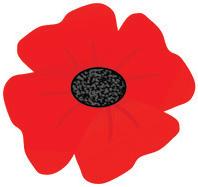
“[My late uncle] was killed in Holland during the Second World War, and my aunt shared some of his collection with me that included Canadian and German hat badges and medals,” McShannon said.

McShannon’s collection of military arti facts dates as far back as a bayonet from the War of 1812 and contains hundreds of mil itary medals, hat badges, photographs and other items. He purchased most from the classifieds section of military medals maga zines, auctions and other collector’s events.
The museum at Veterans Memorial Lodge will display military medals, uni forms and other keepsakes and memora bilia the Lodge’s residents are willing to share. Currently, the plan is to display the museum’s contents in large glass display cases in the Lodge’s Oak Room and other care home locations.
We honour those who ser ved. We will never forget.Haida. He later worked as a Commissionaire at base security checkpoints for over 30 years before his retirement in 2018.
Padre’s Corner: Looking ahead to Remembrance Day

 On Friday, November 11, we will again honour our fallen Canadian Armed Forces personnel. In ceremon ies dotted across the nation, people will pay homage to the more than 112,000 who gave their lives in service of our country.
On Friday, November 11, we will again honour our fallen Canadian Armed Forces personnel. In ceremon ies dotted across the nation, people will pay homage to the more than 112,000 who gave their lives in service of our country.
My first memories of Remembrance Day ceremonies are from my childhood. In Beavers, P.E.I., I was chosen to bear a flag at the local cenotaph ceremony. It seemed quite an honour as the adults demonstrated how to lower the flag correctly. Only later did I appreciate why we gathered every year at the 11th hour of the 11th day of the 11th month.
We live in a time of significant change. We continue to live through a global pandemic. Supply chain issues disrupt commerce. Economic conditions are turbulent. War and sabre-rattling bring great uncertainty to the world. And culture change means we are re-evaluating what traditions we will pass on to our children.
Remembrance Day is one of those traditions we need to teach our children. It still brings meaning to me because someone taught it to us as children. If some thing happened to one of our comrades in arms or me, our society would remember our sacrifice.


Those we honour are not all in the distant past. We lost many in Afghanistan, but even more recently, our Halifax community suffered the loss of Stalker 22. There is always a cost for freedom, and some pay the ultimate price, even in peacetime. Our veterans, old and young, deserve our honour and gratitude.
At every Remembrance Day ceremony, we hear an old refrain: They shall not grow old, As we that are left grow old: Age shall not weary them, nor the years condemn. At the going down of the sun and in the morning We will remember them. And then we respond, “We Will Remember Them”.

While stories of Canadian soldiers on battlefields such as Ypres, Vimy Ridge and Passchendaele loom large, the first Canadian casualties of the First World War were four young midshipmen from Nova Scotia.
“They made the ultimate sacrifice,” said Jennifer Gamble, curator for the Naval Museum of Halifax. Gamble delivered a pres entation on the 108th anniversary of their loss at the Maritime Museum of the Atlantic.
Victor Hatheway (16), Malcolm Cann (16), William Palmer (17) and Arthur Silver (17) died Nov. 1, 1914, when the Royal Navy ship they were on – His Majesty’s Ship (HMS) Good Hope – went down off the coast of Chile after a battle with a German squadron.
The Royal Canadian Navy (RCN) was just one year old in 1911 when they walked through the doors of the Royal Naval College of Canada, housed at the site of the former naval hospital at the Halifax Dockyard.

The four men graduated as midshipmen on Jan. 25, 1913. Years of government inaction meant they graduated into a navy struggling to grow, Gamble said.

“Political turmoil and policy changes threat ened the newly established RCN, and the fund ing allocated to train these men,” she said.
They trained aboard the Royal Navy
cruiser HMS Berwick, earning $2 daily. When the war was declared on Aug. 4, 1914, they reported to the Halifax Dockyard.
Less than two weeks later, Rear-Admiral Sir Christopher Cradock personally selected Palmer and Silver to join his crew to hunt for a German squadron that was sinking allied merchant ships. Cann and Hatheway were chosen by lottery for the two remaining spots. Some of the letters they wrote home are in the Naval Museum of Halifax collection.
On Nov. 1, 1914, Good Hope was patrolling off the coast of Coronel, Chile, when it met up with the German squadron. Outgunned by the Germans, both HMS Good Hope and Monmouth were lost. More than 1,500 died –including the four young midshipmen from Nova Scotia – becoming the first Canadian casualties of the First World War and the first members of the RCN to die in service.

“It was described at the time as one of the worst defeats for the Royal Navy in a century. It was a massive shock for the Royal Navy, the Royal Canadian Navy and all allied nav ies,” Gamble said. “It wasn’t until the end of November that the families received official notice from Ottawa of their deaths.”
Memorial plaques were issued to the families of the dead military members. The museum has Hatheway’s, Cann’s, and Palmer’s plaques as part of its collection.
we salute our canadian armed forces for all their sacrificesCadets of the first intake into the Royal Naval College of Canada in 1911 with their officers and instructors. Arthur Silver (2nd row, 4th from right), Malcolm Cann (3rd row, 1st on left), John Victor Hatheway (4th row, 1st on left), and William Palmer (5th row, 2nd from left) are all pictured with the group. Photo: Naval Museum Of Halifax HMS Good Hope is seen in this undated First World War-era photo. Photo: Imperial War Museum
www.sharkmarine.com








The Canadian Military Sexual Trauma Community of Practice and Trauma and Recovery Research Unit at McMaster University are seeking individuals to take part in a symposium series related to resource development for survivors of military sexual trauma (mst).
Submission Deadline: September 6, 2022

The Canadian Military Sexual Trauma Community of Practice and Trauma and Recovery Research Unit at McMaster University are seeking individuals to take part in a symposium series related to resource development for survivors of military sexual trauma (mst)
The Canadian Military Sexual Trauma Community of Practice and Trauma and Recovery Research Unit at McMaster University are seeking individuals to take part in a symposium series related to resource development for survivors of military sexual trauma (mst) Those interested in sharing how their lived experience of mst can positively impact the rebuilding of relationships within our community are welcome to enter a submission and in so doing a rm that their participation will be a source of healing and constructive information for others in the community.

Those interested in sharing how their lived experience of mst can positively impact the rebuilding of relationships within our community are welcome to enter a submission and in so doing a rm that their participation will be a source of healing and constructive information for others in the community. Canadian
Those interested in sharing how their lived experience of mst can positively impact the rebuilding of relationships within our community are welcome to enter a submission and in so doing a rm that their participation will be a source of healing and constructive information for others in the community.
Shark Marine proudly supports the Canadian Armed Forces.
We pay tribute to the men and women, past and present, who make the sacrifices that allow all Canadians to enjoy life in this great country.







His journey with addiction began years ago, with painkillers prescribed by his doc tor to treat back pain. It didn’t end until he graduated from fentanyl and survived a near-fatal, unintentional overdose.
Today, Dr. Darryl Jordan Gebien is a survivor of Canada’s opioid crisis, in longterm recovery, and admits he is lucky to be alive.
“I hope through this discussion we can learn from each other,” Dr. Gebien says.

Dr. Gebien is the next speaker in the MARPAC Health and Wellness Fall Speakers Bureau series. He plans on taking

his audience on a journey of his epic fall and arduous rise from opioid use disorder with a discussion titled A Compassionate Lens of Addiction. The talk coincides with National Addiction Awareness Week.
In November 2014, Dr. Gebien, an emer gency room physician from Thornhill, Ont., was arrested and eventually incarcer ated for abusing his prescription-writing privileges.
Despite losing contact with his young family and career, Dr. Gebien pressed on in his recovery, frequently sharing at Narcotics Anonymous and Alcoholics Anonymous 12-step meetings.
“Pain, stress, worry, anxiety and depres sion affect us all, but it is how we choose
to deal with them that makes it easier to overcome,” he says. “Both physical and mental pain, as well as poor coping skills contributed to my addiction, and healing only began within the comfort of being with others after I surrendered.”
Dr. Gebien says he wants to share his 15 keys to happiness learned during his recovery.

“I am thrilled to share my story and interact with members of the Defence team from across the country,” Dr. Gebien said.
Dr. Gebien will share his experience on Nov. 22 from 10 to 11:30 a.m. on MS Teams.
Doctor Gebien is in long term recovery from opioid use disorder and lucky to be alive. His remarkable story has been the subject of national media atten tion. He is an ER physician as well as a former federal inmate.

He was incarcerated in 2017 due to abusing his prescription-writing privileges to feed an out-of-control addiction. It all started innocently years earlier with pain killers prescribed by his doctor to treat back pain. It ended after his arrest in 2014 but not before graduating to fentanyl and surviving an unintentional, near-fatal overdose.
His tumultuous journey involved a harrowing drug detox followed by the psychological chaos of early recovery and post-acute withdrawal syndrome. Despite losing everything including his freedom (residing six months at various drug rehabs, one month in jail and eight months of prison), Dr. Gebien pressed on by frequently attending and ‘sharing’ at 12-step meetings. It was here where he found his voice and renewed confidence, learning that although others could criticize his opinions, his emotions and feelings were off limits. Sharing emotions in a safe environment had unexpected rewards.
The deeper he dug in, exploring personality flaws and the painful past for example, the greater the benefit was on his well-being.
363-1900
The Elsie Initiative.
Canada’s Feminist Foreign Policy.
National Action Plan on Women, Peace and Security.
Many Canadians may not be familiar with these important initiatives while living in a peaceful coun try. However, for the countries HMCS Winnipeg visited during Operation Projection, these topics are very much front and centre.
With a female Commanding Officer (CO) and female Coxswain (Cox’n), HMCS Winnipeg was in a unique position to provide speakers on these topics. In several ports, Commander (Cdr) Annick Fortin, the CO, and Chief Petty Officer First Class (CPO1) Sue Frisby, Cox’n, spoke at Women, Peace and Security (WPS) events about their experiences as women leaders in a male-dominated environ ment, and what the Canadian Armed Forces has done, and continues to do, to promote equality.
For the Winnipeg’s CO and Cox’n, the issue around Women, Peace and Security was distilled down to a grassroots level: “What is it like to be a female leader in a male-dominated environment?”
Thirty years ago, HMCS Nipigon was refitted to
Canada’s Feminist Foreign Policy.
National Action Plan on Women, Peace and Security.
become the first destroyer to accommodate the first Regular Force women as part of the ship’s crew. Now, women serve on all RCN vessels, and in all positions. Although the path ahead of us is likely as long as the one behind, we should still take time to pause, reflect, and acknowledge how far we have come and how much we have achieved. Canada as a nation continues to recognize the need for both equity and equality, aiming for a future with equal opportunity.
As the WPS discussions continued throughout several port visits, it was an eye-opening reminder of how other nations look to us as an example of what can be.
At the Women, Peace and Security dialogue in Jakarta, Indonesia, Colonel Nely Indraningrum of the Indonesian Armed Forces shared that she had never been asked to speak publicly. Meeting Cdr Fortin and CPO1 Frisby and witnessing their con fidence as they spoke both inspired and impressed Col Nely.
In Singapore, the CO was invited to an aca demic roundtable that included Women, Peace and Security in the agenda. She was the only female there.
In Malaysia, the CO and Cox’n, along with four sailors, were invited to speak to 500 students at an
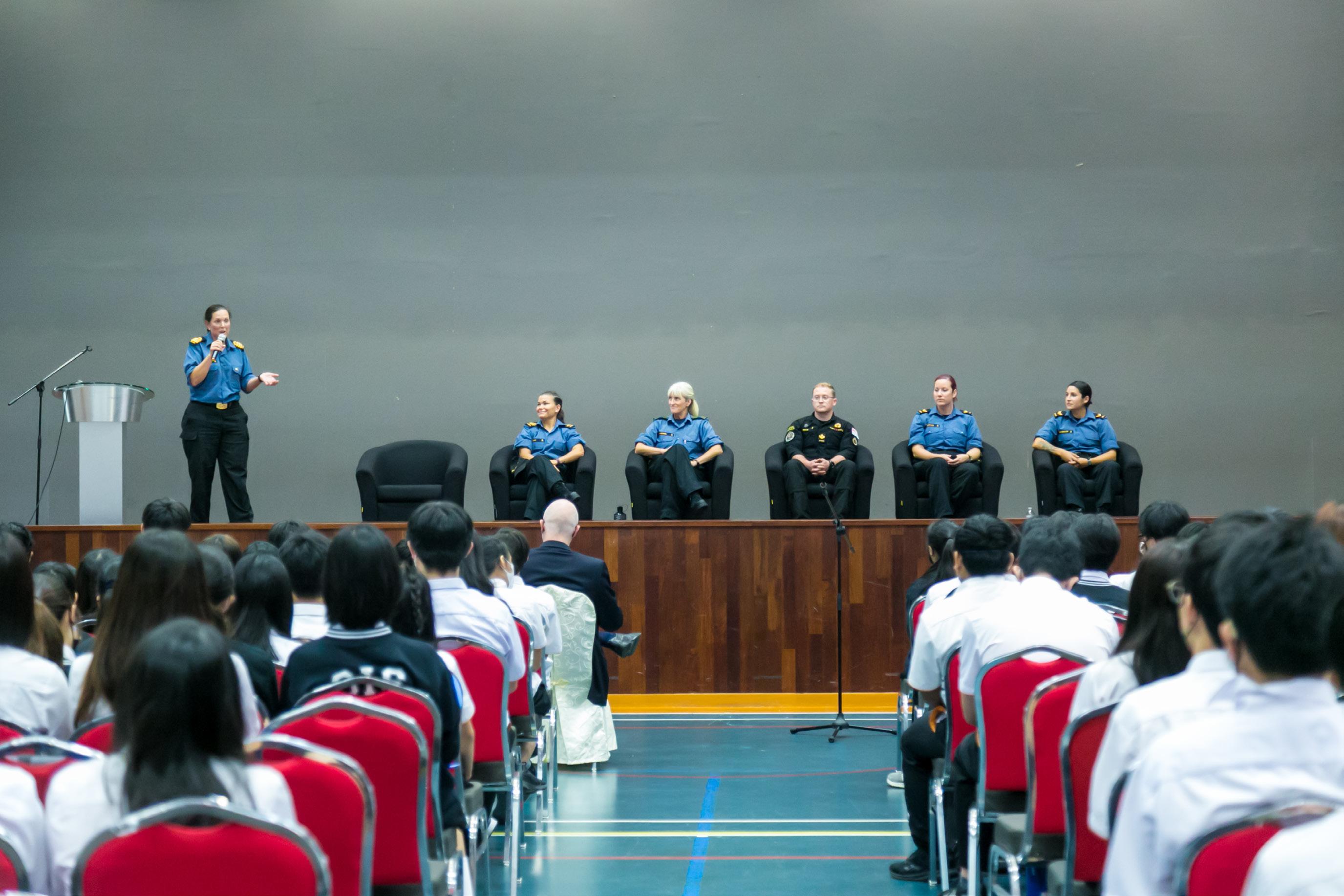
international school about being women in the Navy, a male-dominated field. The students had questions that ranged from cyber-security to “were you scared the first time you went on a ship”. The real impact of this was especially notable after the presentation, as students came up to get photos with the speakers; many of the students spoke of being inspired and more confident in setting their future goals.

In Thailand, the CO and Cox’n were invited to another Women, Peace and Security event. Other speakers included Colonel Jiraporn Chomsri of the Royal Thai Army, and Commander Chittrathip Warnpeurch and Captain Mathusorn Lertpanich of the Royal Thai Navy (RTN). In the RTN, women can only serve in support roles, they cannot go on ships. Cdr Chittrathip said in her speech, “It is my happiness to see Cdr Fortin here, captain of a warship, and know that it is possible for men and women to sail together”.
At all these events, guests wanted their photo taken with RCN women, stories were shared, and visions for the future emerged. These conversations have been an excellent reminder for us as Canadians to take a step back and appreciate how far we have come.


The Victoria Royals will wear a spe cially-designed historic replica jersey of the 1942/43 Navy team while facing off against the Prince George Cougars. The Western Hockey League team revealed the jersey Nov. 15.

“It’s a forgotten story of what could be argued as the greatest single season of hockey played on Vancouver Island,” said Matt Carlson, Base Public Affairs Projects Officer. “The players were all members of the Royal Canadian Navy (RCN) and called to serve in the war effort and stationed at CFB Esquimalt.”






Victoria Royals players will wear the jersey for a Canadian Armed Forces (CAF) Appreciation event at the Save on Foods Memorial Centre. The white jersey with blue stripes features a bull dog wearing a sailor’s cap with the words ‘HMCS’ inscribed.

Derived from a black and white photo from the CFB Esquimalt Naval and Military Museum archives, the jer sey commemorates the 80th anniversary of the Base’s star-studded team that competed in the Island Senior League (ISL). The team was comprised of both National Hockey League (NHL) and minor league players from across Canada.



Dubbed by the Victoria Daily Times as the ‘bluejackets’, the team featured Chucky Rayner, Hockey Hall of Fame and Canada Sports Hall of Fame goaltender, whose NHL career was interrupted by the Second World War. Rayner served three years in the RCN before resuming his career in New York with the Rangers. He went on to win the NHL’s Hart Trophy for Most Valuable Player in 1950.
Also in the ‘bluejackets’ lineup was Bob ‘Golden Boy’ Goldham, five-time

Stanley Cup winner and defenceman. After serving in the military from 1942 to 1945, Goldham played 11 NHL seasons with Toronto, Detroit and Chicago.

Bernie Strongman, another hokey player from Victoria, also was a vet eran of the Royal Canadian Navy, and enjoyed a successful professional hockey career that he finished as captain of the Victoria Cougars in 1953.
Carlson said along with celebrat ing the Navy’s intriguing and largely unheralded hockey history, the event will also honour current members of the Defence team.
“Along with this wonderful tip to hockey heritage, this CAF apprecia tion event will also include dynamic, interactive interior and exterior dis plays,” said Carlson. “This event is all about community building in partner ship with the Royals while recognizing and highlighting the amazing work the Defence team does.”
The Royals CAF Appreciation event will also include static dis plays and demonstrations by Naval Reserve Unit HMCS Malahat, 443 Helicopter Squadron, 5th (British Columbia) Field Artillery Regiment, 39 Signal Regiment, Regional Cadet Support Unit Pacific, the Esquimalt Military Family Resource Centre, HMCS Venture R&D, CFB Esquimalt Naval & Military Museum, Search and Rescue Dog Association (SARDAV) CFB Esquimalt Base Fire Services, Military Police Unit (Esquimalt) and the Canadian Forces Recruiting Centre. The opening ceremonies will feature PO 1 Bligh from the Naden Band signing the National Anthem, a three flag colour party and the Base Commander Captain (Navy) J. Jeffrey Hutchinson dropping the ceremonial puck at 6:05 p.m
Unit Chiefs. Discounted tickets of $15 are also available


















 Peter Mallett Staff Writer
Peter Mallett Staff Writer
The A/B Jetty Recapitalization Project is currently the largest construction pro ject in the harbour and is anticipated to be completed in the mid-2020s.
Defence Team members revealed the project’s details at the Oct. 27 Public Information Session at the Songhees Wellness Centre.
“We heard many positive comments on the progress that has been made in the cleaning up of contaminated sediments,” said Michael Bodman, Manager of Base Safety and Environment. “This included comments about the increased number


of observations of sea life in Esquimalt Harbour including whales, herring, and other fish species.”

Approximately 70 people, primarily residents close to the Department of National Defence (DND) and Esquimalt Graving Dock facilities, used the session as an opportunity to raise concerns about noise from various sources, learn where the sediment went for disposal and the archaeological materials recovered during dredging projects and showed interest in how local Indigenous communities have been engaged in the project.
The DND is undertaking several pro jects in Esquimalt Harbour associated

with CFB Esquimalt. The projects are addressing the historic harbour contam ination and are continuing to transform the Dockyard infrastructure to sup port the Royal Canadian Navy (RCN) operations.
“In the long term, DND will continue to work with partners in the surround ing communities to monitor condition of Esquimalt Harbour, manage risk and identify projects that will contribute to the ongoing goal of a healthy and sustain able environment,” Bodman said.
The A-Jetty open water remediation, B-Jetty demolition, and remediation are completed, with B-Jetty construction
underway. The remediation of G-Jetty and Jetty 11 on the Colwood side of Esquimalt Harbour is currently in the procurement phase and is expected to commence by the end of 2022.
The current A Jetty and former B Jetty is now over 70 years old, says Bodman.
“Along with providing important updates, information sessions such as this one also highlight the Government of Canada’s investment in enabling and supporting the RCN through investing in new infrastructure, protecting the environment and cleaning up contam ination caused by historical activities,” Bodman said.

as shore power and cranes to conduct work since they can not bring that overseas. As such, Lt(N) Chung said the RAMP is challenging to do in a developing country or a port with limited resources.
A great deal of planning and work goes into a Rest and Maintenance Period (RAMP) for a Royal Canadian Navy ship.

“A RAMP is like a mini work period that focuses on a ship’s operational deficiencies, overdue maintenance, and anything else that will affect the post-deployment work period,” said Lieutenant (Navy) Kevin Chung, the RAMP In-Charge of the maintenance project.
Before HMCS Vancouver conducted a RAMP in Busan, South Korea, Oct. 4-11, the Production Management team at Fleet Maintenance Facility (FMF) Cape Breton reviewed the project to better prepare a feasible work pack age, given the limited resources and duration of the work required.


“This is a critical step as anything that is missed during this review could result in work not being completed in a foreign port,” said Steve Ringma, Vancouver’s RAMP Production Team Manager.
He said his team relies on port services such

A ship will only get one RAMP per deployment, Lt(N) Chung. Depending on the state of the ship and where the ship sits in the operational cycle, a RAMP may or may not occur.
The amount of personnel needed for a project, as well as the length of the RAMP, depends on the information in the work package.
“We sent 33 technicians from 15 different trades, con ducting maintenance deemed critical by Fleet Engineering Readiness,” Ringma said.
Ringma said the FMF RAMP team did a great job executing the work period.
“It was great to see the team adjust and be flexible as challenges arose,” he said. “We had excellent support from the team back at FMF, especially considering the time differ ence, everyone was very reactive.”
During Vancouver’s RAMP period, crew members could take leave and explore the country or remain aboard the ship during the day and visit the city in the evening.
This was the first time FMF CB used a service flight to support deployed vessels in a foreign port. The FMF CB RAMP team was flown in and out of Korea using an RCAF Service flight on a C17 Globemaster. This allowed the team, the luggage, the tools, and all materials to be transported together.




Powell River-based Sunshine Coast Health Centre and the Georgia Strait Womens Clinic provide highly personalized addiction, mental health and trauma treatment for male and female clients respectively. Get daily 1-on-1 inpatient or outpatient treatment tailored to your unique needs.





Services include 24 hourmedical service, psychiatric assessment, EMDR, rTMS, psychotherapy, hypnotherapy and much more.
Serving the Department of National Defence and Veterans Affairs Canada since 2009.